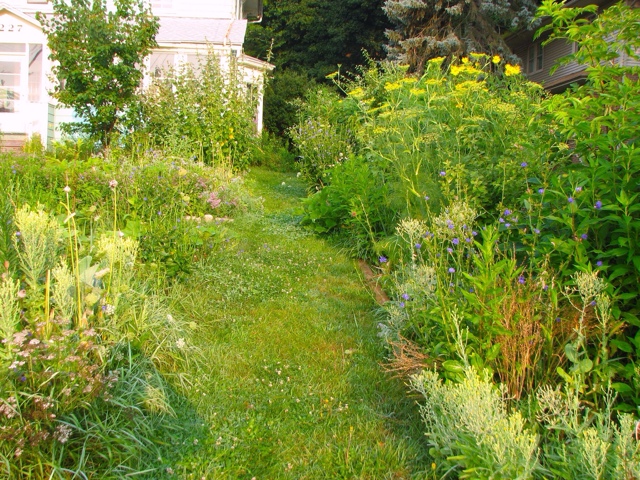Sunday, December 7, 2014
"Permaculture" from a Lost Age
Thursday, December 4, 2014
Gravity Heat: the Complexity of Energy Efficiency
2. Dependable: few moving parts, no fans, baffles, computers, plus strong long-lived materials, little to go wrong.
3. Ecological impact of embodied energy: As an annualized impact, this equipment's ecological footprint is tiny, even assuming impractically large efficiency improvements, an honest evaluation including the embodied energy of new ductowrk, etc. makes it unlikely that furnace replacement would "pay off" in the lifetime of a furnace.
4. Financial
5. Depressurized heating efficiency in an old house: lab tests of efficiency assume the relative air-tightness of a modern home. In a leaky victorian home, there are efficiencies that come with not having heat "forced" out of the home by a blower. It's hard to measure this factor, but it shouldn't be discounted when calculating supposed benefits of newer furnaces.
6. Reasonably Upgradable: efficiency improvements can be made such as updating the ignition, adding thermal mass, and installing radiator coils in the flue pipe, which was popular in the 70s and can capture 40-50% of the "lost" heat, bringing efficiency into the range of modern heaters. Unlike a new furnace, these improvements would pay for themselves in a few short years.
All things considered, it's impossible for me to justify unnecessary replacement of our gravity furnace on ecological, efficiency or financial grounds. It just goes to show that the conventional advice isn't always right, and fancy "efficiency upgrades" sold by the industry don't always work out to be more efficient when you do the numbers.
Some day, this beast will come to the end of its life and it will be time to replace it. Even then, this analysis shows there may be ecological and financial benefits to eschewing fancy "green" high-efficiency equipment promoted by "green living experts," with so many short-lived parts, fussy electronics and high embodied energy for more "appropriate" tech that's simpler, longer-lived, more adaptable, and less expensive.
Monday, December 1, 2014
The Quince--a Great Permaculture Tree Crop
Japanese Flowering Quince: http://www.pfaf.org/user/Plant.aspx?LatinName=Chaenomeles+speciosa
Monday, November 24, 2014
Designing a Permaculture Hedgerow
Thursday, November 13, 2014
Permaculture Garden in Early Winter
Tuesday, November 11, 2014
Alternative Paths to Wealth
Wednesday, October 29, 2014
And Now for Something Totally Different
Goofing around with a newish piece, haven't really bothered to learn all the words yet. I think I got some of 'em right, though.
Monday, October 20, 2014
Social Elements in A Food Forest
Sunday, October 19, 2014
Fall Morning
Monday, September 29, 2014
Permaculture Principle: Obtain a Yield
 |
| Autumn Olive Pasta Sauce--Delicious! |
What makes that investment of each individual's time and effort possible is that they are rewarded for this activity. Everything that lives has to "obtain a yield." For those of us who are natural "do-gooders," inclined to give freely of ourselves, this may be the most important Permaculture principle.
When we "only give" we do work that is ultimately unsustainable. But it's also potentially dangerous. There's a wisdom inherent in the collaborative "enlightened self interest" of natural communities, which keeps everyone working a niche and obtaining a yield from it. When we create systems or communities that bypass this, where we give without obtaining a yield, there's a danger that we will disrupt a natural connection where someone else could "help themselves" and obtain a yield in doing the work we did for free. Often times, such as in our well-meaning interventions in low-income or natural communities, we end up hurting the people we intend to help, preventing community members from starting businesses and enriching the ecology of their community.
I believe our garden will be a "good work" that will build the ecology of or community. And it's a joy to do. But I have to admit, it makes it easier to commit the time when our garden "pays" us in some very tasty things to eat!
Wednesday, September 24, 2014
Mushrooms Note
As I have been "under the weather" over the last few days, I haven't gotten around to posting additional mushroom info and resources yet. I will make sure to get them up as soon as I'm feeling up to snuff.
Thanks again for the fun time,
Mike
Thursday, September 18, 2014
Early Fall Garden
Well, besides very nice crop of peas, and a few tomatoes and peppers, we really never got around to "putting in" our garden this year. And most of what we did put in became lunch for wildlife. We never tilled or dug any garden beds. We did hand cast a few seeds now and then, but we never dug in seeds in any traditional way. We never watered, almost never weeded, certainly never added fertlizer.
Tuesday, September 16, 2014
Easy Sidewalk Garden with Sheet Mulching
Tuesday, September 2, 2014
Tour of Lillie House

Welcome to a virtual tour of our home, built by the Lillie Family sometime in the mid 1800s.
Yet It provides us with fruit, herbs, vegetables, and salads virtually every day of the year, and a true relationship with nature and our food.
They evolved in a time when things were made with quality materials meant to last, with designs intended to be maintained indefinitely and lived in comfortably with low energy inputs.























































